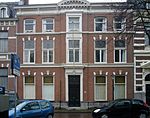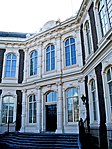Willemspark

The Willemspark (Dutch pronunciation: [ˈʋɪləmsˌpɑr(ə)k], literally William's Park) is a neighbourhood in the Centrum district of The Hague, Netherlands. It has 1,393 inhabitants (as of 1 January 2013) and covers an area of 34.6 hectares (0.134 sq mi). It is bordered by the Zeestraat to the south-east, the Scheveningseveer, the Mauritskade and the Dr. Kuyperstraat to the south-east, the Prinsessegracht to the north-east and the Javastraat to the north-west. The park was originally property of king William II, but he sold the area to the municipality of The Hague in 1855, after which it became a villa park. Iconic to the neighbourhood are the Alexanderstraat and the Sophialaan that intersect on Plein 1813. This square is marked by a monument commemorating the defeat of Napoleon and the establishment of the Sovereign Principality of the United Netherlands.
Excerpt from the Wikipedia article Willemspark (License: CC BY-SA 3.0, Authors, Images).Willemspark
Sophialaan, The Hague Centrum
Geographical coordinates (GPS) Address Nearby Places Show on map
Geographical coordinates (GPS)
| Latitude | Longitude |
|---|---|
| N 52.0869 ° | E 4.3075 ° |
Address
Sophialaan 11
2514 JR The Hague, Centrum
South Holland, Netherlands
Open on Google Maps









